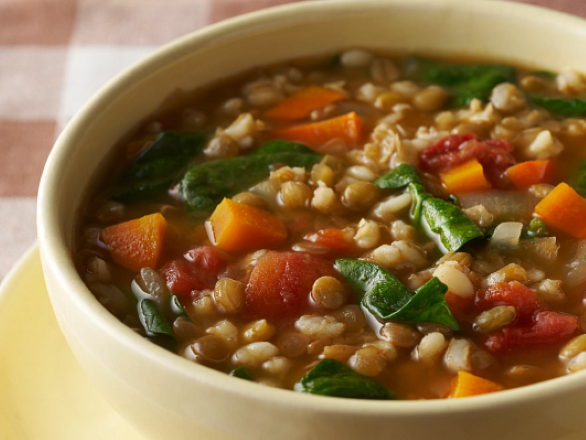In this edition
- Gratitude: An Important Practice Across the Lifespan
- Step-by-Step Pasta Dinner
- Barley and Lentil Soup
About the Newsletter
Learn how to foster gratitude in your life. Often, we miss the good, getting caught up in our thoughts or getting to the next thing. By paying attention to the good in our lives, gratitude will naturally arise. Learn two ways to practice gratitude in your own life.
Gratitude: An Important Practice Across the Lifespan
By Heather Haslem, M.S.
Heather Haslem is the senior project coordinator, workforce development for the Center for the Application of Substance Abuse Technologies at the University of Nevada, Reno.

Two people walking down a sandy beach.
Gratitude has been described as an emotion, a virtue, a motive, a skill, an action, an attitude and a practice. Psychologists define gratitude as a deeper appreciation for someone (or something) that produces lasting positivity. We tend to think gratitude is simply saying “thank you” to someone. However, it is a daily practice that we can cultivate over time and throughout our lives. According to researchers, as a person ages, they tend to become more grateful. Research has also shown that gratitude becomes easier with age. One area it becomes very helpful for older adults is focusing on what matters most versus wishes of what might have been different. When a person gets caught up wishing things were different, it can be challenging for their mental health and impacts physical health. Some people are resistant to the practice of gratitude. It can seem fluffy, or just another thing we should do. Some people set expectations that we should feel grateful, indebted, or obliged for the things that they did for us.
Perhaps you’ve heard someone say, “You should be more grateful for all I’ve done.” It turns out that it’s harder for us to feel gratitude when there is an expectation attached to it. Gratitude naturally arises and isn’t anything we should feel. So, how can we foster more gratitude in our lives? Often, we miss the good, getting caught up in our thoughts or getting to the next thing. By paying attention to the good in our lives, gratitude will naturally arise. Since gratitude is a practice, here are two practices for you to consider trying.
Stop to Notice the Little Things
Each day take time to stop and notice the good in your life. Look around and notice:
- The beauty found in nature
- The gift of life (e.g., breathing, moving your body)
- The gift of being nurtured (kindness by others)
Once you’ve noticed them, allow yourself to feel gratitude. Breathe in the feeling of appreciation. Share with others so they can see and experience the good too.
Write a Gratitude Letter
Take a moment to accept the good in your life. A reminder to say yes to the life that’s right here. Recognize a source of goodness from someone other than yourself. Think of someone in your life who you are particularly grateful for. Someone who when you think of them brings you joy. Reflect on the benefits you have received from this person and write a letter expressing your gratitude for what they have done and/or what their presence means to you. Once you’ve written the letter, deliver it to this person (either virtually or in person). Spend time connecting with this person who has been so meaningful to you. Research has demonstrated that practicing gratitude has many benefits. Some include experiencing a greater sense of meaning in life, an increased sense of well-being, improved optimism, increased happiness, a stronger sense of self, better relationships, and enhanced physical and mental health. Isn’t it amazing, that by simply stopping to acknowledge the good in our lives, we can experience so many positive benefits?
Step-by-Step Pasta Dinner
Pasta is a budget friendly way to choose whole grains.

A plate of pasta with marinara sauce and parmesan cheese.
Pick one item from each category!
Pasta (1/2 pound): Whole wheat pasta or brown rice pasta.
Protein: Lean ground meat, cooked and drained. Beans rinsed and drained (1 can or 2 cups). Frozen peas (2 cups). Chicken or turkey sausage, cooked and sliced (1 pound)
Veggies (2 cups total, any combo): Spinach, chard, kale, broccoli, carrots, sugar snap, snow peas, zucchini or yellow squash.
Sauce (1-2 cups): Marinara, peanut sauce, canned diced or crushed tomatoes, cheese sauce or White sauce.
Seasonings (Optional, to taste): Dried or fresh basil, dried or fresh oregano, garlic powder or fresh minced garlic.
Barley and Lentil Soup

Barley lentil soup with various vegetables.
January is declared as the “unofficial” national soup month and Jan. 6 celebrates National Bean Day. With cold temperatures and chilly days, it's the perfect time to celebrate with a warm bowl of this healthy and hearty soup.
Ingredients:
- 4 cups fresh spinach
- ¾ cup pearl barley
- 1 tablespoon canola oil
- 1 teaspoon ground paprika
- ½ teaspoon ground cayenne pepper
- 6 cups water
- 4 cups low-sodium chicken or vegetable broth
- 1 cup dried lentils
- 1 (14½-ounce) can diced tomatoes, no salt added
- 1 teaspoon salt
- ¼ teaspoon ground black pepper
Optional Ingredients: ¼ cup grated parmesan cheese
Instructions:
- Rinse, peel and dice carrots and onions. Peel and mince garlic. Rinse and chop spinach.
- In a colander, rinse barley with cold water. • In a large pot, add oil. Heat over medium-high heat. Add carrots and onions. Cook until slightly soft, about 5 minutes.
- Add garlic, paprika and cayenne pepper to pot. Stir and cook for 30 seconds.
- Add barley, water and broth to pot. Bring to a boil. Reduce heat to low. Partially cover with a lid and simmer for 15 minutes.
- In a colander, rinse lentils with cold water. Add lentils to pot, along with tomatoes. Cover and simmer for 30 minutes.
- Add spinach to soup and stir. Cover and simmer for 5 more minutes.
- Add salt and pepper and stir.
- If using parmesan cheese, add now.
Chef’s Notes
- If soup is too thick, add extra liquid (water or broth) to your taste.
- Beans and grains continue to absorb water when stored in the fridge.
- When reheating leftover soup, add water or broth as needed.
- Use kale, chard, or collard greens in place of spinach, if you like.
- For a more filling and healthier soup, add more colorful veggies.
To view more recipes from cooking matters


